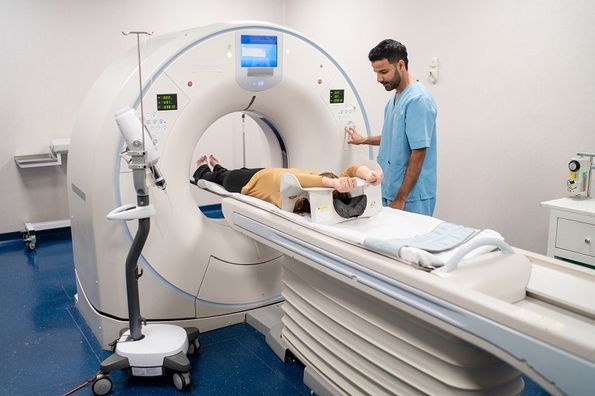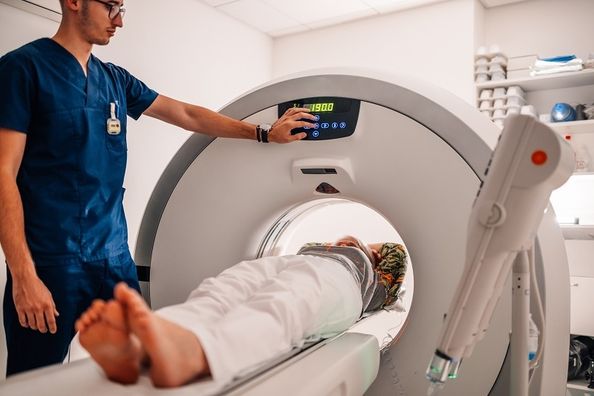Ever wondered why imaging services can vary so dramatically in price and quality? You’re not alone!
Imaging services are medical tests ordered by your primary care or specialty provider that take pictures of what’s happening inside your body. What many people don’t realize is that these services can differ significantly depending on where you go, not just in cost, but in technology quality, radiologist expertise, and overall convenience.
When you shop around, you can find facilities with more advanced equipment that produce clearer images with less radiation. You might find centers with radiologists who sub-specialize in specific body areas, providing more accurate interpretations. More often than not, outpatient facilities offer lower costs due to limited or no facility fees, better access with convenient appointments, shorter wait times, and easier parking than hospital-based services.
Think of shopping for imaging like shopping for a car; you wouldn’t buy the first one you see without comparing options. The same goes for these important medical tests.
At Duly Health and Care, our overall out-of-pocket costs are typically 20 – 40% lower than hospital systems, while offering the same or better technology and physician expertise. That’s significant savings without compromising quality!
Let’s take a look at how to compare services using CPT codes, decide whether self-pay might be cheaper than using insurance, and what to look for in a quality imaging center.
Know What Imaging Test You Need
Before you start shopping, make sure you understand exactly what test your doctor is ordering and why.
Be curious and ask your provider: “What does this test help diagnose?” to ensure you get the proper test for your needs.
Here’s a quick rundown of common imaging types:
- X‑rays are like quick snapshots of your bones and some tissues. They’re perfect for checking for broken bones or lung issues and typically cost the least.
- Ultrasounds use sound waves to create images; no radiation involved! They’re often used to look at organs, blood vessels, or during pregnancy. Plus, you can sometimes watch the screen during your exam.
- CT scans (or CAT scans) combine multiple X‑rays to create cross-sectional images. They’re great for diagnosing internal issues like appendicitis or kidney stones and show more detail than regular X‑rays.
- MRIs use powerful magnets to provide the most detailed images of your soft tissues, joints, and brain. All without using radiation! They take longer but can offer a different insight into medical issues.
Ask for the CPT Code
Here’s a pro tip that can save you serious money: ask for the CPT code for your imaging test.
CPT (Current Procedural Terminology) codes are like universal product numbers for medical procedures. Every imaging test has a specific code; for example, a brain MRI without contrast might be CPT 70551.
Why does this matter? Because it’s your golden ticket to comparison shopping! With the exact code in hand, you can call different facilities and compare apples to apples. Without it, you might end up comparing prices for different tests entirely.
Simply call your doctor’s office or the imaging scheduler and say: “I’d like the specific CPT code for my ordered imaging test, please.” Write it down, you’ll need it for the next steps.
Get Pricing from Your Original Facility
Start with the facility where your doctor initially referred you. This gives you a baseline price to compare with other options.
Call the billing department and ask for two different quotes:
- An insurance-based estimate (what you’ll pay with your insurance)
- The self-pay price (what you’d pay without insurance)
Remember to mention your deductible and specific insurance plan to get the most accurate out-of-pocket estimate. Many facilities also offer online tools, like Duly’s MyChart billing estimates feature, to quickly obtain this information.
The surprising part is that if you haven’t met your deductible yet, the self-pay price might be cheaper than using your insurance! This happens because self-pay rates are often discounted compared to what facilities bill insurance companies.
Take a look at your current deductible status:
- Have you met your deductible for the year? If yes, your insurance might cover most of the cost.
- Still far from meeting it? Self-pay might be your friend.
Write down both prices and keep them handy for comparison.
Compare Prices at Other Imaging Centers
Look beyond hospital-based facilities to independent imaging centers, outpatient clinics, or free-standing radiology centers near you.
To find them:
- Search online for “imaging centers near me”
- Ask your provider for recommendations
- Check your insurance company’s provider directory
- Use price comparison tools like Expected Healthcare
When you call these facilities, have your CPT code ready and ask:
- “Do you accept self-pay patients?”
- “What’s your price for CPT code [insert your code]?”
- “Do you offer any discounts or payment plans?”
Consider Insurance vs Self-Pay
Now that you have prices from different facilities, it’s time to decide between insurance and self-pay. This is where a little math comes in handy!
Take a look at your current deductible status:
- Have you met your deductible for the year? If yes, your insurance might cover most of the cost.
- Still far from meeting it? Self-pay might be your friend.
Using insurance has its perks:
- The cost counts toward your yearly deductible
- Once you’ve met your deductible, you’ll typically pay less out-of-pocket
- You won’t need to submit claims yourself
But self-pay can be surprisingly wallet-friendly:
- Upfront costs are often lower than insurance rates
- No surprise bills later, you pay once, and you’re done
- Some facilities offer additional discounts for paying at the time of service
What works best depends on your specific situation and healthcare needs for the rest of the year.
Switch Facilities (If You Want To)
Have you found a different imaging center that better meets your needs? Making the switch is easier than you might think!
Here’s what to do:
- Call your doctor’s office and let them know you’d like your imaging done at a different facility
- Ask them to send your order to the new location (usually done by fax)
- Follow up with the new facility to confirm they’ve received your order
- Schedule your appointment
Your doctor’s office handles this kind of request all the time, so don’t feel awkward about asking! They want what’s best for you, including affordable care.
Double-check that the new facility has everything they need before you arrive. This includes your insurance information (if you use insurance), the complete order, prior authorizations, and any special instructions from your doctor.
What to Look for in an Imaging Center Beyond Price
While saving money feels great, quality matters too! Here’s what to consider beyond the price tag:
Quality Assurance
- Look for ACR (American College of Radiology) accreditation. This means the facility meets high standards for image quality and safety
- Ask about their equipment. Newer machines often provide clearer images with less radiation
- Check if board-certified radiologists read the results, their expertise makes a big difference in spotting potential issues
- Consider radiologist sub-specialization. Facilities where radiologists focus on specific areas (like breast imaging specialists reading mammograms or neuroradiologists interpreting brain MRIs) can provide more accurate and detailed interpretations. These subspecialized experts have additional training and experience with specific body regions and conditions, potentially leading to better diagnostic outcomes.
Convenience Factors
- Can you schedule appointments online?
- How soon can they get you in? Some centers offer same-day or next-day appointments.
- Do they provide digital access to your results through a patient portal?
- Is the location easy to get to with parking nearby?
Customer Experience
- Read online reviews from other patients
- How helpful is the staff when you call with questions?
- Will they explain the procedure clearly before you arrive?
- Do they offer reminders about preparation instructions?
Remember that the cheapest facility isn’t always the best value. Sometimes, paying a bit more for a center with newer equipment and experienced staff is worth it for peace of mind and accurate results.
Common Pitfalls to Avoid
Even savvy healthcare shoppers can fall into a few traps when looking for imaging services. Here are some common mistakes to watch out for:
- Assuming your provider’s referral is your only option. When your doctor hands you an imaging order with a specific facility listed, it’s natural to think you must go there. Not true! That referral is often just a suggestion, and you’re free to take it elsewhere.
- Forgetting to ask about pricing up front. Walking into an imaging appointment without knowing the cost is like handing someone a blank check. Always get estimates before your appointment to avoid sticker shock when the bill arrives.
- Overlooking quality to save a few bucks. While saving money is great, the cheapest option isn’t always the best choice if the image quality suffers. Poor quality scans might mean you’ll need to repeat the test, which costs more in the long run.
- Not factoring in convenience. A facility that’s an hour away might save you $100, but is that worth taking extra time off work, paying for gas, and dealing with the stress of traveling when you’re not feeling well? Sometimes the closest option is worth a little extra.
- Missing hidden fees. Some facilities charge separate fees for the radiologist’s interpretation. Always ask: “Does this price include all fees, including the radiologist’s reading?”
Tools and Resources to Make It Easier
The good news? You don’t have to navigate this process alone! Here are some helpful resources to guide your imaging shopping journey:
Your insurance company’s online directory can help identify in-network facilities and sometimes even provide cost estimates based on your specific plan and deductible status.
Hospital and healthcare system websites increasingly offer price transparency tools. Look for “cost estimator” or “billing” sections where you can enter your insurance information for personalized estimates.
Your provider’s office can be an excellent resource. Many doctors and their staff know more affordable imaging options and can point you in the right direction.
Be Informed, Not Overcharged
You wouldn’t buy a car without checking prices at different dealerships, so why accept the first price you’re given for an important medical test?
Let’s recap how to shop smart for imaging:
- Get the exact CPT code for your test
- Compare prices at multiple facilities
- Weigh the benefits of insurance versus self-pay
- Consider quality, convenience, and overall value
It’s okay to ask questions and advocate for yourself. Your healthcare providers want what’s best for you, and that includes affordable care.
With just a little research and a few phone calls, you can save hundreds or even thousands of dollars without sacrificing quality. Those savings can go to better use for things like your family’s budget, or to give you peace of mind during your healthcare journey.
At Duly Health and Care, we believe in transparent pricing and helping you make informed decisions about your healthcare. Our radiology team provides high-quality imaging services with state-of-the-art technology and is always ready to help you understand your options.
Want to explore your imaging options with Duly Health and Care? Call us at 630−545−7880 with questions or to schedule an appointment today. We offer flexible weekend and evening hours to accommodate your schedule.
Health Topics:





